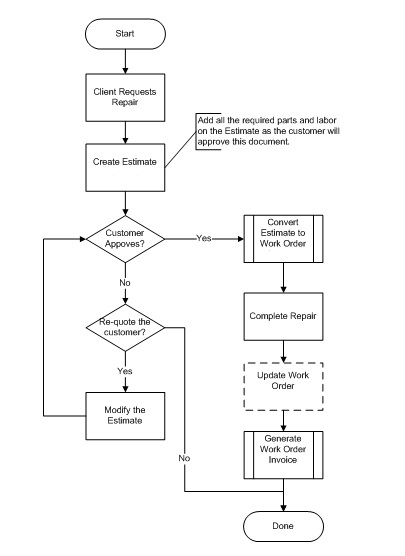Customer Work Order Overview
Work Order Overview Information Guide -> Customer Work Order Overview
Typically, Work Orders bill repair jobs for customers. The Work Orders can be used two ways:
1.MANUAL WORK ORDERS
(the Work Order is manually completed then entered into the software):
oUse a pre-numbered preprinted Work Order
oShop staff manually writes on the Work Order the amount of labor, the part numbers etc used to complete the job - shop staff does not need to look up the prices of the parts
oWhen the job is finished, it is entered using the number on the Work Order instead of the Auto Assign number. The operator types in the part numbers and the software finds the selling price, and relieves parts inventory.
oAfter the Work Order is entered, the Work Order can be printed out for the Shop Manager to approve the totals, before proceeding with the final billing.
oThe Work Order is billed, creating an Invoice.
Advantages & Disadvantages:
oThis approach works well in small to medium sized firms, where parts inventory is not considered a significant investment
oThis approach works well when shop staff are reluctant to use the software. Instead, counter staff enter the Work Order and create the Invoice.
oParts inventory is maintained, however, it represents only Work Orders completed.
oJob Lists of outstanding Work Orders cannot be maintained by the software.
2.COMPUTERIZED WORK ORDERS
(the Work Order is completely done using the software):
oThe Work Order is setup by the shop staff at the beginning of the job, i.e. when the equipment to be repaired is received. The software assigns the Work Order #.
oThe Work Order is printed, describing the equipment to be repaired and the work to be done. The printed Work Order is used in place of a preprinted Work Order to manually write on the labor used and any shop notes. These are typed into the computer later.
oAs parts are required, the Parts Department staff adds them immediately to the Work Order on the computer, enabling the parts inventory to be completely up to date at all times.
oWhen the Work Order is finished, the shop staff bill it, creating the final invoice.
Advantages & Disadvantages:
oThis is the better alternative for medium to large firms where the parts inventory is considered a significant investment, and the service department is very active.
oThis approach works well when parts and shop staff both agree to use the software.
oThe parts inventory is kept completely up to date.
oThe software can create Job Lists of outstanding Work Orders, which help to organize and prioritize the work in progress. This is needed for large service departments.
Process flow for a Customer Work Order:

Topic Keyword: WO000504